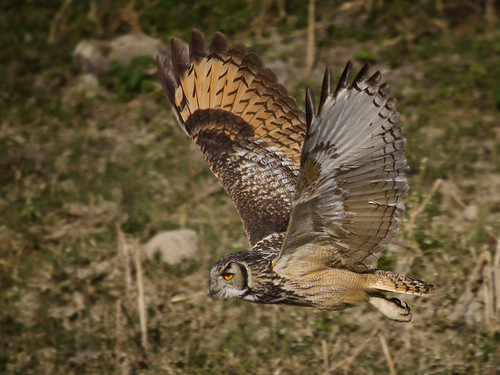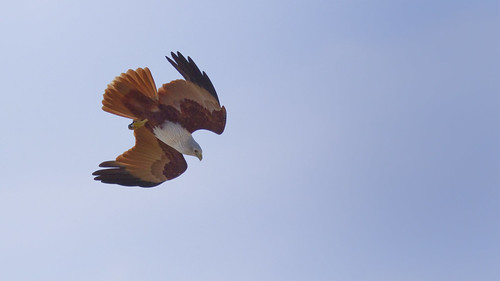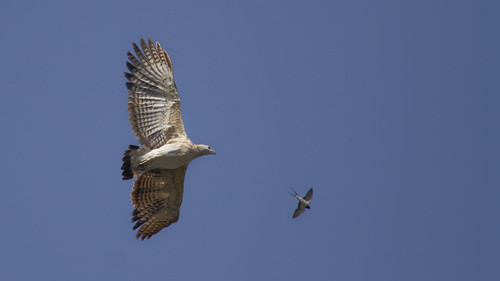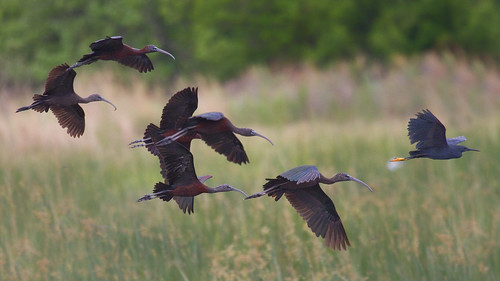
Capturing birds in flight is a vexing subject for many newbie bird photographers. Well instead of just randomly trying to get a shot if you think and plan consciously the subject is not at all difficult to master and the results are indeed very satisfying. Am writing down here a few points which can get you started in the right direction – these are by no means the only things you must do, just somethings which have worked out right for me
- Know your birds: Just like any other subjects that you photograph you have to be aware of the characteristics of the bird that you are trying to shoot. A few thumb rules are
– Larger birds are slow flyers, Storks, Egrets, Pelicans and Ducks are all excellent subjects to being with. As are larger birds of prey
– When a bird takes to air it usually first jumps it the air with wings in a upstroke, then there is a strong downstroke. The second upstroke is a great moment to click
– Several larger birds also hover for example Black-winged kite or a Short-toed snake eagle, not just sun birds or humming birds - Get the funda right: At the heart of it a lot of in flight bird photography is about knowing how to pan the camera correctly. If you have never taken panning shots practice on something other than birds, people, vehicles… Keep a firm but relaxed grip on the camera, keep the body stable so that you are sure you are not going to fall. Try to keep the subject in your view finder all the time – take heart it improves with time. Find the bird as it approaches you not when it is passing you by
- Get the right camera body: While it is almost always true that it is the man behind the camera who makes a great photograph, the camera, when it comes to in flight photography counts for a lot. I got much better results with my Canon EOS 1D MarkIII and 7D than my 60D because the in former two Auto Focus (AF) locked on much faster. This however should not put you off – as long as you know the limits of your camera + lens combination you can always make a good shot
- Get the right lens: Faster lenses with Ultra Sonic Motors (USM) motors focus faster, Similarly bigger aperture lenses focus faster so f2.8 is better than a f4 and for the same reasons avoid tele-converters. For more understanding about lenses read this FAQ
- Start small: This time I mean start with a smaller focal length, 200mm is about right if you have never done this before. Trust me this also improves with time. I can now pan with my 1000mm on a tripod but 400mm is sweet soft spot for me when it comes to hand holding the camera and still getting a lot of keepers. Also remember to lock the focus limiter button if your camera has one.
- Which shooting mode: Tv or Av? There is no perfect answer but I go by the following thumb rules
– Bright daylight use Av mode the camera will adjust the shutter speed to a be high enough
– Somewhat cloudy situations shift to Tv mode where you can choose the shutter speed to be at least 1/800th of a sec.
– Smaller the bird the faster shutter speed you will need to freeze it, however do experiment with speeds. Wing blurs can give very interesting pictures - Which focusing mode and Focus points: AI Servo mode with either Center AF focus point or if your camera supports Center + the immediate periphery ones work the best for me. If you are not familiar with focusing modes refer to your camera manual or this FAQ
- Keep at it: The first few time you may not get any keepers but persistence will pay. Also shoot hundreds show a just a couple. Even if you have several sharp pictures pick out just one which has the birds just perfectly poised
Feel free to comment and add any other tips you may have for photographing birds in flight – happy shooting!




There are even more examples of birds in flight on my flickr stream – take a look